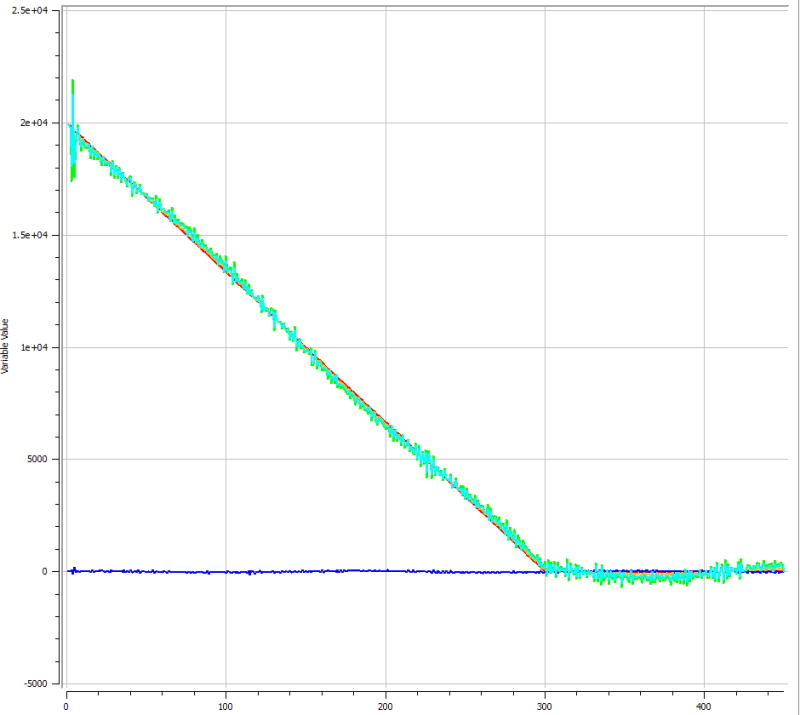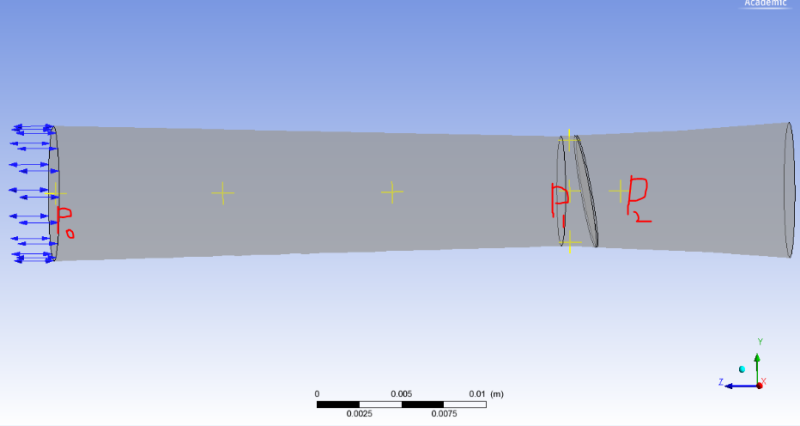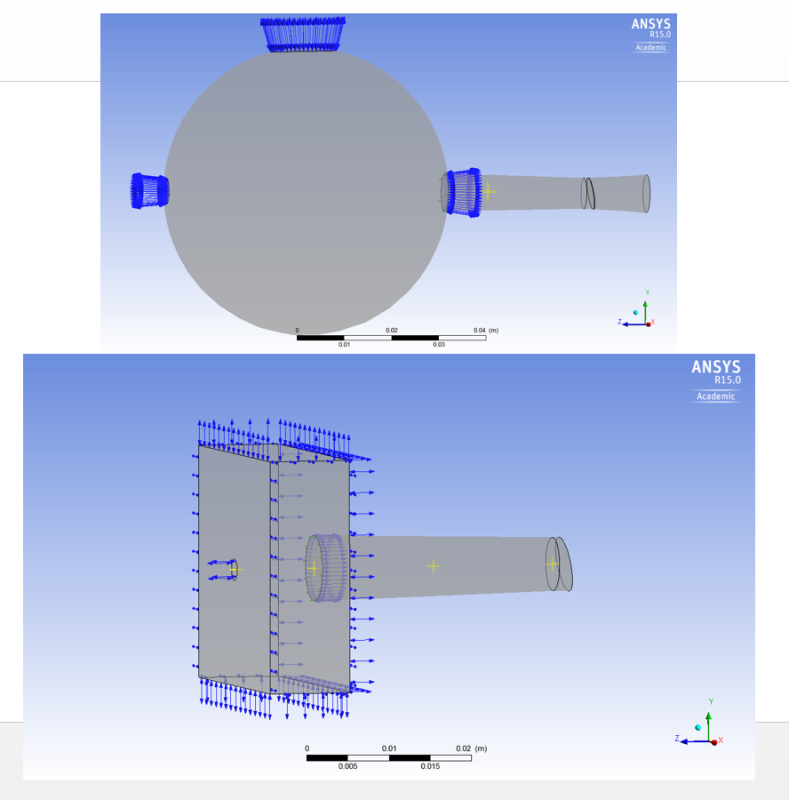Hello,
Using ANSYS/CFX it is my goal to apply an impulse, time-dependent pressure (representative of a simplified blast wave) to the ear canal and examine the pressure distribution from P0, P1, and P2 as pictured in [Incident pressure waveform.PNG] showing the 3 ms pressure application & [2.PNG] showing the model and monitor points. I have been facing many difficulties with this conceptual model, most of which are due to CFX nonconvergence (and sometimes Total Mesh Displacement read errors at an FSI, or negative element volume). These issues arise especially when physiological, flexible eardrum properties are used (20 MPa) vs default structural steel.
Initially, I defined the pressure as a time-dependent IF expression at the entrance of the canal. Although the Opening boundary condition was utilized, an artificial wall was erected at the boundary resulting in excessive reflections and negative pressures (as is described in documentation regarding artificial walls at Inlets and Outlets).
In finding a new method for the pressure application I then tried:
· Implementing beta-feature Acoustic Reflectivity
o This “far field” type pressure application destroyed the characteristic impulse pressure desired.
· Initializing a domain/subdomain
o This approach destroys the time-dependent criteria.
· Using CEL to describe a pressure at a location (say, for z>3 mm)
o This appears to only be applicable for domain initialization, losing time dependence.
· Adding an additional domain for pressure application as seen in [Flow field.PNG]
o Failed generally
and
· Applying a source at the FSI to add a Mass Flux Pressure Coefficient as is recommended to improve FSI convergence according to the Stabilization Demo in the ANSYS Customer Portal
o As the pressure wave strikes the ear drum (P1), dynamic pressure effects increase the pressure value 2-4 times P0 values. This pressure coefficient appears to “damp” or slow the pressure’s application to the FSI and dynamic pressure effects are subsequently lost. Additionally, structural displacements are two orders lower when this source is applied. [4.PNG] shows the loss of dynamic pressure when using the same model conditions (using steel properties instead of flexible mat. props.), the first without this source damping, the second with.
All of the above approaches had major convergence problems. Many of these methods I’ve combined. I’ve also experimented with smaller timesteps (E-8), much denser meshes, and the Max. Coeff. Loops and Max. Iterations parameters.
Ideally, I’d like to be able to flexibly apply a pressure that is a function of x,y,z,t. What I need is to be able to apply a pressure that maintains impulse, time-dependent characteristics and dynamic effects to a model that converges when using flexible. I feel as if I’ve exhausted my options in CFX. I would be tremendously appreciative of any help I can receive in solving this pressure app/convergence problem. Maybe AutoDYN or something other than Transient Structural/CFX?
If there is any confusion or anything needing further elucidation, please let me know.
Thank you,
Kegan Leckness




Using ANSYS/CFX it is my goal to apply an impulse, time-dependent pressure (representative of a simplified blast wave) to the ear canal and examine the pressure distribution from P0, P1, and P2 as pictured in [Incident pressure waveform.PNG] showing the 3 ms pressure application & [2.PNG] showing the model and monitor points. I have been facing many difficulties with this conceptual model, most of which are due to CFX nonconvergence (and sometimes Total Mesh Displacement read errors at an FSI, or negative element volume). These issues arise especially when physiological, flexible eardrum properties are used (20 MPa) vs default structural steel.
Initially, I defined the pressure as a time-dependent IF expression at the entrance of the canal. Although the Opening boundary condition was utilized, an artificial wall was erected at the boundary resulting in excessive reflections and negative pressures (as is described in documentation regarding artificial walls at Inlets and Outlets).
In finding a new method for the pressure application I then tried:
· Implementing beta-feature Acoustic Reflectivity
o This “far field” type pressure application destroyed the characteristic impulse pressure desired.
· Initializing a domain/subdomain
o This approach destroys the time-dependent criteria.
· Using CEL to describe a pressure at a location (say, for z>3 mm)
o This appears to only be applicable for domain initialization, losing time dependence.
· Adding an additional domain for pressure application as seen in [Flow field.PNG]
o Failed generally
and
· Applying a source at the FSI to add a Mass Flux Pressure Coefficient as is recommended to improve FSI convergence according to the Stabilization Demo in the ANSYS Customer Portal
o As the pressure wave strikes the ear drum (P1), dynamic pressure effects increase the pressure value 2-4 times P0 values. This pressure coefficient appears to “damp” or slow the pressure’s application to the FSI and dynamic pressure effects are subsequently lost. Additionally, structural displacements are two orders lower when this source is applied. [4.PNG] shows the loss of dynamic pressure when using the same model conditions (using steel properties instead of flexible mat. props.), the first without this source damping, the second with.
All of the above approaches had major convergence problems. Many of these methods I’ve combined. I’ve also experimented with smaller timesteps (E-8), much denser meshes, and the Max. Coeff. Loops and Max. Iterations parameters.
Ideally, I’d like to be able to flexibly apply a pressure that is a function of x,y,z,t. What I need is to be able to apply a pressure that maintains impulse, time-dependent characteristics and dynamic effects to a model that converges when using flexible. I feel as if I’ve exhausted my options in CFX. I would be tremendously appreciative of any help I can receive in solving this pressure app/convergence problem. Maybe AutoDYN or something other than Transient Structural/CFX?
If there is any confusion or anything needing further elucidation, please let me know.
Thank you,
Kegan Leckness




